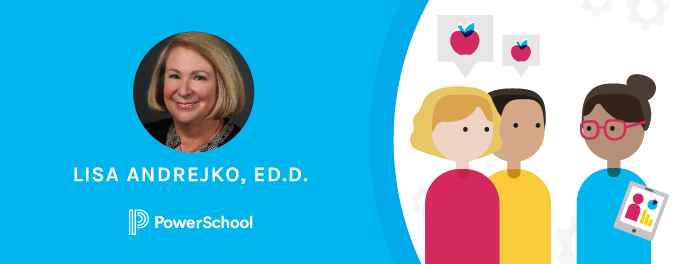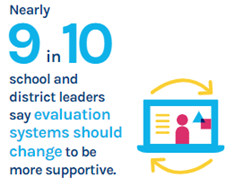Supporting Teachers to Drive Retention: New Research Findings and Best Practices

Dr. Lisa Andrejko, Director of Education Solutions at PowerSchool, has more than 30 years of K-12 experience as an educator and superintendent. She’s an active thought leader who speaks at conferences, hosts webinars and panel discussions, and authors content for the education community.
Teacher retention remains a high priority for districts across the U.S., and it’s no wonder why. Classroom educators make the most direct impact on student learning (as Rand Corporation Research shows), yet every state continues to feel the effects of a nationwide teacher shortage. Now, as districts look ahead from more than two years of operating through a global pandemic, they’re prioritizing teacher support to counter increasing retention challenges.
While keeping teachers in classrooms isn’t a new priority, it’s certainly getting renewed focus. This year’s PowerSchool Education Focus Report: Top District Priorities and Shifts in PK-12 Education reveals building an exceptional workforce as one of the top priorities of districts nationwide. It highlights increased staffing challenges and identifies “a less stressful work environment” as the leading factor luring today’s teachers away from the profession. Additionally, National Education Association (NEA) survey data cited in the report shows that 55% of educators plan to leave teaching earlier than they had planned. Even though resignations remain well below that level for most districts, the NEA data still shows a troubling dissatisfaction among today’s teachers.
Districts often report that they already spend a substantial amount of their budgets on investments in teachers and staff, but further improving support may be more attainable than some realize within current budget constraints. Initial investments in support structures and initiatives that promote collaboration and community among educators can yield years of dividends. Plus, funding now available through federal K-12 relief programs like ESSER can cover teacher-supporting technology purchases.
In this blog, I’ll share some ideas districts can use to improve teacher support and retention. Exploring findings from the PowerSchool Education Focus Report, we’ll see what survey data from thousands of educators and districts’ strategic plans say about the current teacher retention crisis. I’ll also share tips from my own experience and best practices for improving teacher support.
Elevating Onboarding and Mentoring Programs to Pave a Successful Career Journey
First impressions can be profound. That’s why it’s important to show teachers right from the start how much their time, commitment to the profession, and career success are valued. Plus, a thorough, convenient onboarding program that doesn’t feel rushed starts them off on the right foot. Simplifying the onboarding process is a great way to do this. By reducing the paperwork burden and enabling fast, convenient online form completions, you can give school leaders more time to focus on welcoming new teachers and ensuring they’re fully prepared for their first day.
Colleague-to-colleague professional mentoring is also crucial to supporting teacher wellbeing and growth. It also creates a path for hard-earned experience and instructional knowledge to get passed down, contributing to long-term district success. A survey question in our Education Focus Report revealed that regular, ongoing coaching tops the list of most valuable professional learning activities, according to educators. In fact, their top three selections center around collaboration and sustained learning.
Starting teachers off strong with an easy, thorough onboarding program, then continuing to support them with access to professional learning communities (PLCs) and a robust mentoring program, if possible, can make a huge impact on long-term retention. These initiatives show them your district wants to invest in their success. It also gives them the tools they need to build a long, successful career. Combined, improving onboarding, access to PLCs, and mentoring contribute to improving teachers’ lives and classroom success at your school or district for years to come.
Rethinking Evaluations as Opportunities to Discuss and Plan Growth
Many feel the compliance-based model of teacher evaluations has run its course—that it doesn’t provide teachers with the support they need. By focusing on accountability rather than growth, the experience becomes something to “get through” rather than one to walk away from with real value and intent.
K-12 leadership knows this, and they want to make positive changes. Looking again at findings from the Education Focus Report survey, nearly 9 in 10 school and district leaders said evaluation systems should change to be more supportive.
Of all survey respondents, 48% said teacher evaluations should more equally balance teacher support and accountability. While there’s certainly room for state departments of education to better align evaluation requirements with supporting teachers rather than judging them, school and district leaders can begin to lead the change. Here’s what that could look like in practice:
❶ The Observation:
Administrator recognizes a skill that could help a teacher better connect with students during lessons.
❷ The Growth Discussion:
“You approached that lesson really well, but I noticed you were
really encouraging students to explore the topic by asking more questions.
We have a PD course that I think would help you spark even more curiosity in
future lessons.”
❸ The Plan:
“So let’s do this: We’ll put that course in your PD plan, then we can schedule a
check-in next month
to see how it’s going and how you feel it may be helping you in the classroom.”
❹ The Check-In:
The teacher and administrator meet at the pre-scheduled time to discuss the quality of the assigned PD course,
the value the teacher gained from it, and any other concerns or questions the teacher still has.
Growth conversations followed by check-ins give teachers and administrators chances to build trust, respect, and understanding. The best part is that this approach of supporting, listening, and personalizing PD activities does an even better job of helping teachers grow the skills they need to improve instructional effectiveness. In the end, students benefit immensely.
Offering Meaningful, Personalized Professional Development
A “one-size fits” approach to PD risks wasting teachers’ time and missing out on crucial opportunities to maximize positive impact on student learning. Every teacher, classroom, school, and district are unique. Identifying their needs, and most importantly, where each teacher needs support, enables administrators to tailor PD plans so that time committed to them returns the most value for all concerned. Growth conversations and scheduled check-ins throughout the year create opportunities to spot, address, and follow up on each individual’s needs.
Of course, practicality comes into play. A barrier for many who’d like to personalize teacher support is scale—how do you connect with each teacher when your teams are already spread thin? This is where technology plays a key role.
Digital forms and processes, along with online communication, automated workflows, and integrated systems, can eliminate many of the time-consuming aspects of personalizing talent management. Technology can also give administrators more information to work with by making historical evaluations and student performance data easily accessible. The truth is that even large districts can personalize PD with the right tools in place.
Establishing a Culture of Support with Attention to SEL Details
Culture makes all the difference in sustaining a shift toward supporting teachers and promoting collaboration. It’s people who drive change. Support comes naturally when everyone approaches interactions with the intention to listen, understand, value, and learn.
At the district level, talent leaders indicate in the Education Focus Report that “adequate support and staffing to do the job well” is equal to “adequate pay or benefits” in a list of most important factors for improving staff retention. Teachers need a pressure valve to release daily stress and larger concerns, like teaching as a viable career into the future. While rethinking teacher evaluations to emphasize professional and personal support as one part of the puzzle, teachers also need to focus on building skills to help them reach their full potential.
This is why the CASEL core competencies come into play when supporting teachers. While SEL for students continues to gain attention in K-12 education, it’s important to also incorporate it into teacher PD plans. These skills help them cope with challenges, seek growth, and prioritize self-care. In a time when so many cite workplace stress as a reason for moving on from teaching, SEL for teachers provides a set of tools for facing recent obstacles.
Supporting Teachers with Technology and Informing Decisions with Data
Looking at scaling personalized teacher support and a culture that promotes SEL values, technology again becomes crucial. It’s something districts indicate room for improvement in PowerSchool’s Education Focus Report. Less than half of survey respondents said their district uses technology effectively to support talent needs. And while professional learning topped the talent needs that are supported by technology, it’s clear many could do much more to serve teachers.
When it comes to professional learning, technology offers substantial benefits. An intuitive online platform for accessing PD plans, professional learning content, and support from colleagues and leaders gives teachers the freedom to pursue PD anytime, anywhere. That means no more staying late, coming in early, or building their schedules around traditional virtual or in-person “sit-and-get” learning sessions. Going further, integrating professional learning and teacher evaluation tools can make it even easier for teachers and administrators to discuss learning options as part of growth conversations and check-ins.
For talent leaders, technology can also provide deep data insights to inform decisions at every level—from district-wide recruiting and hiring to mentor assignments and professional learning course suggestions. Big-picture data can show teachers’ development needs at one school vs. another. It can help administrators identify their strongest mentor candidates and match them with the appropriate junior educator. Professional learning course reviews by teachers can even show which ones deliver the most value.
Helping Teachers Get Back to Why They Chose the Profession
Teachers are the most important link between today’s students and tomorrow’s leaders, caregivers, thinkers, builders, problem-solvers, and, of course, educators. Most of us fondly remember a teacher who made a profound impact on who we are today. Every student deserves that. That’s why keeping talented, impactful teachers in classrooms is key to the future of PK-12 education.
However, teachers can’t do it all on their own. A strong support structure is key, especially in the face of challenges like workplace stress, uncertainties, and ever-present compensation issues. Giving teachers the coaching, attention, and tools they need to grow their skills can help them achieve the career goals that initially brought them back into the classroom as educators.
